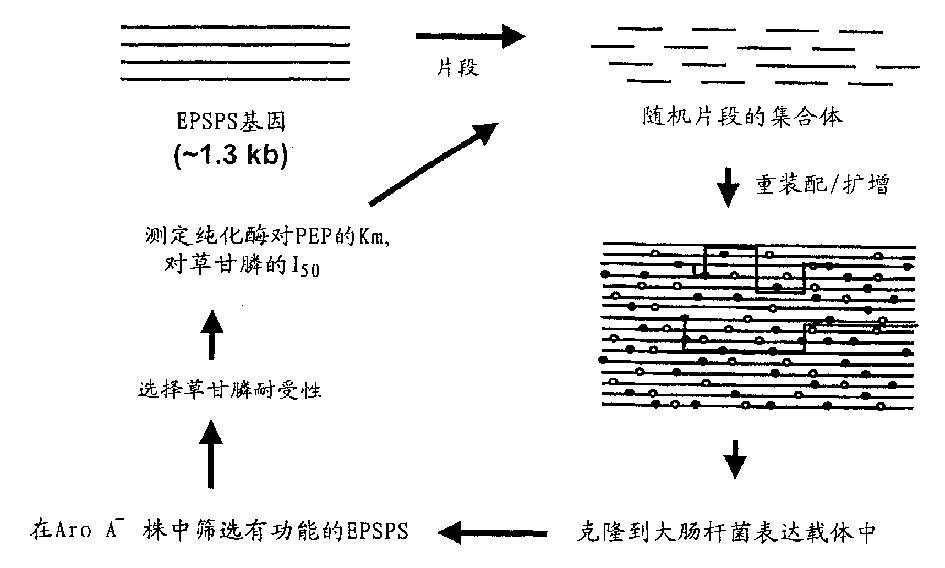DNA shuffling to produce herbicide selective crops
A herbicide and active technology, applied in the field of herbicide-selective crops produced by DNA recombination, can solve problems such as heavy workload
- Summary
- Abstract
- Description
- Claims
- Application Information
AI Technical Summary
Problems solved by technology
Method used
Image
Examples
preparation example Construction
[0216] The present invention refers to a number of methods known in the art for producing transformable protoplasts of various plants and then transforming cultured protoplasts. See, eg, Hashmoto et al. (1990), Plant Physiol. 93:857; Plant Protoplasts, edited by Fowke LC and Constabel F, CRC Press (1994); Saunders et al. (1993), Plant In Vitro Symposium on Applications in Technology, UPM, 16-18, November 1993; and Lyznik et al. (1991), Bio Techniques 10:295, which are incorporated herein by reference.
[0217] chloroplast
[0218] The chloroplast may be the site of action for some herbicide tolerance, and, sometimes, the product of a herbicide tolerance gene is preferentially fused to a chloroplast transit sequence peptide, thereby facilitating entry of the gene product into the chloroplast. At this point, the shuffled herbicide tolerance nucleic acid is preferably transformed into the chloroplast of the plant host cell. Chloroplast transformation and expression can be perfo...
Embodiment 1
[0245] Example 1: Shuffling of plant EPSPS genes for glyphosate tolerance
[0246] Arabidopsis EPSPS cDNA was PCR amplified from reverse transcribed RNA using primers 5'GCAGT CCATG GAGAA AAGCG TCGGA GATTG TACTT CAACC C-3' and 5'-TAGAC TAAGA TCTGT GCTTT GTGAT TCTTT CAAGT ACTTG G-3'. This fragment was digested with NcoI and BglII, and then directionally cloned into the prokaryotic expression vector pQE60 (QIAGEN) and introduced into E. coli AroA AB2829 (Pittard, 1966). Likewise, tomato cDNA was amplified from purified phage DNA from a cDNA library (Stratagene) with primers 5′-ACGTC CATGG CAAAA CCCCA TGAGA TTGTG CTAG-3′ and 5′-CAGTA GATCT GTGCT TAGAG TACTT CTGGA G-3′ and cloned into pQE60 , and introduced into AB2829 cells. Growth of transformed cells on minimal medium lacking aromatic amino acids demonstrated that the function of the AroA mutation was complemented by the expression of the cloned EPSPS gene.
[0247] The Arabidopsis and tomato EPSPS genes cloned from pQE60 were...
Embodiment 2
[0249] Example 2: Glyphosate tolerance of recombinant forms of EPSP synthase
[0250] The positive activity of EPSP synthase was determined by monitoring phosphate production with the malachite green colorimetric assay (Lanzetta PA et al., Anal. Biochem. 100:95-97, 1979). Reactions were performed in assay buffer (50 mM HEPES, pH 7.0 and 0.1 mM ammonium molybdate) containing enzymes, 0.1 mM phosphoenolpyruvate, 0.1 mM shikimate-3-phosphate, and various concentrations of glyphosate, The final volume is 0.2 ml. After 20 minutes, 0.7 mL of malachite green reagent (3 parts 0.045% malachite green to 1 part 4.2% ammonium molybdate) was added to stop the reaction. After 10 minutes, the absorbance at 660 nm was measured with a Beckman DU600 spectrophotometer. The inhibition constant (150) for each enzyme against glyphosate was obtained from the plot of percent activity versus glyphosate concentration. The K for PEP was obtained from a plot of the rate of product formation versus PEP...
PUM
 Login to View More
Login to View More Abstract
Description
Claims
Application Information
 Login to View More
Login to View More - R&D Engineer
- R&D Manager
- IP Professional
- Industry Leading Data Capabilities
- Powerful AI technology
- Patent DNA Extraction
Browse by: Latest US Patents, China's latest patents, Technical Efficacy Thesaurus, Application Domain, Technology Topic, Popular Technical Reports.
© 2024 PatSnap. All rights reserved.Legal|Privacy policy|Modern Slavery Act Transparency Statement|Sitemap|About US| Contact US: help@patsnap.com









